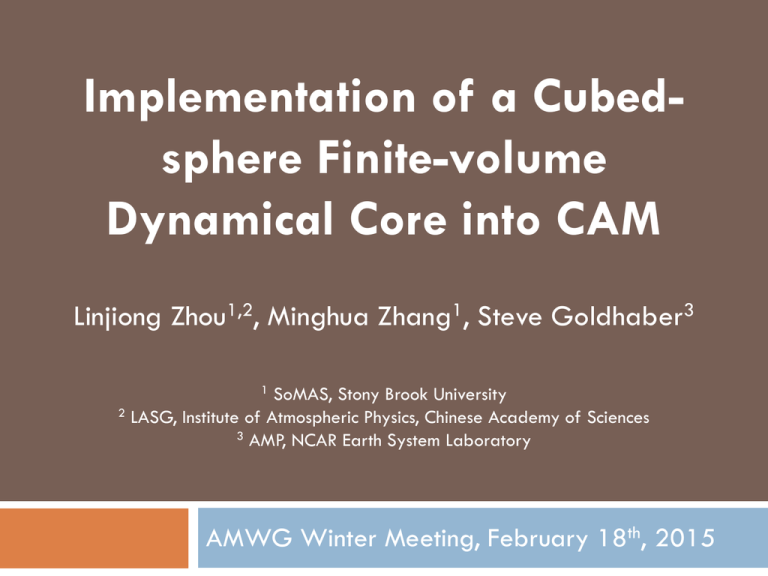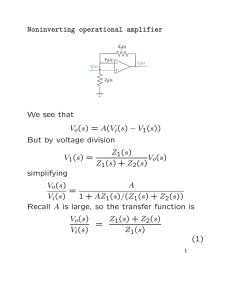On the Incident Solar Radiation in Some CMIP5 Models
advertisement

Implementation of a Cubedsphere Finite-volume Dynamical Core into CAM Linjiong Zhou1,2, Minghua Zhang1, Steve Goldhaber3 1 SoMAS, Stony Brook University 2 LASG, Institute of Atmospheric Physics, Chinese Academy of Sciences 3 AMP, NCAR Earth System Laboratory AMWG Winter Meeting, February 18th, 2015 Motivation Cubed-sphere FV dynamical core (FV3) is the latest dynamical core developed in GFDL that already been employed in the AM3/HiRAM. The Institute of Atmospheric Physics (IAP) of the Chinese Academy of Sciences (CAS) is evaluating several dynamical cores for high resolution atmospheric simulations. The mainly updates from FV to FV3 are: Replace lat-lon grid with cubed-sphere grid (Putman and Lin, 2007) The flux-form semi-Lagrangian extension (Lin and Rood, 1996) needed to stabilize the (large time step) transport processes in FV near the poles is no longer needed (Donner et al., 2011) in FV3 The polar Fourier filtering is no longer needed in FV3 (Donner et al., 2011) Advantage: 1) improved computational efficiency and communication load balancing 2) higher efficiency in high resolution integration What We Have Done Under the instruction from Steve Goldhaber. Computational Performance CESM1.2.2 Dynamics Resolution Model Speed* CPU Amount FV3 C48_f19_g16 (200km) 3.60 / 2.14 96 FV f19_g16 (200km) 10.08 / 3.08 64 SE ne16_g37 (200km) 2.91 / 1.77 64 FV3 C96_f09_g16 (100km) 4.64 / 1.85 216 FV f09_g16 (100km) 1.72 / 0.58 128 SE ne30_g16 (100km) 0.99 / 0.65 128 FV3 C192_f05_g16 (50km) 1.34 / 0.66 384 FV f05_g16 (50km) 0.50 / 0.05 256 SE ne60_g16 (50km) NA NA Component Setting: FAMIP/FAMIPC5 (CAM4/5+CLM4.0+RTM+DOCN+CICE) Machine: Storm, Local Cluster in SoMAS, Stony Brook University * Units: Model Year / Wall-clock Day (CAM4 / CAM5) Computational Performance CESM1.2.2 Dynamics Resolution Model Speed* CPU Amount FV3 C48_f19_g16 (200km) 3.60 / 2.14 96 FV f19_g16 (200km) 10.08 / 3.08 64 SE ne16_g37 (200km) 2.91 / 1.77 64 FV3 C96_f09_g16 (100km) 4.64 / 1.85 216 FV f09_g16 (100km) 1.72 / 0.58 128 SE ne30_g16 (100km) 0.99 / 0.65 128 FV3 C192_f05_g16 (50km) 1.34 / 0.66 384 FV f05_g16 (50km) 0.50 / 0.05 256 SE ne60_g16 (50km) NA NA Component Setting: FAMIP/FAMIPC5 (CAM4/5+CLM4.0+RTM+DOCN+CICE) Machine: Storm, Local Cluster in SoMAS, Stony Brook University * Units: Model Year / Wall-clock Day (CAM4 / CAM5) Computational Performance CESM1.2.2 Dynamics Resolution Model Speed* CPU Amount FV3 C48_f19_g16 (200km) 3.60 / 2.14 96 FV f19_g16 (200km) 10.08 / 3.08 64 SE ne16_g37 (200km) 2.91 / 1.77 64 FV3 C96_f09_g16 (100km) 4.64 / 1.85 216 FV f09_g16 (100km) 1.72 / 0.58 128 SE ne30_g16 (100km) 0.99 / 0.65 128 FV3 C192_f05_g16 (50km) 1.34 / 0.66 384 FV f05_g16 (50km) 0.50 / 0.05 256 SE ne60_g16 (50km) NA NA Component Setting: FAMIP/FAMIPC5 (CAM4/5+CLM4.0+RTM+DOCN+CICE) Machine: Storm, Local Cluster in SoMAS, Stony Brook University * Units: Model Year / Wall-clock Day (CAM4 / CAM5) Computational Performance CESM1.2.2 Dynamics Resolution Model Speed* CPU Amount Rate# FV3 C48_f19_g16 (200km) 3.60 / 2.14 96 37.5 / 22.3 FV f19_g16 (200km) 10.08 / 3.08 64 157.5 / 48.1 SE ne16_g37 (200km) 2.91 / 1.77 64 45.5 / 27.7 FV3 C96_f09_g16 (100km) 4.64 / 1.85 216 21.5 / 8.6 FV f09_g16 (100km) 1.72 / 0.58 128 13.4 / 4.5 SE ne30_g16 (100km) 0.99 / 0.65 128 7.7 / 5.1 FV3 C192_f05_g16 (50km) 1.34 / 0.66 384 3.5 / 1.7 FV f05_g16 (50km) 0.50 / 0.05 256 2.0 / 0.2 SE ne60_g16 (50km) NA NA NA Component Setting: FAMIP/FAMIPC5 (CAM4/5+CLM4.0+RTM+DOCN+CICE) Machine: Storm, Local Cluster in SoMAS, Stony Brook University * Units: Model Year / Wall-clock Day (CAM4 / CAM5) # Rate: Model Speed * 1000 / CPU Amount. The higher the better! Experiments for Evaluation CESM1.2.2 Experiment Dynamical Core Physical Package Analysis Period FV3_C4* Cubed-sphere Finite-volume CAM4 1981-1995 (15yrs) FV_C4* Lat-lon Finite-volume CAM4 1981-1995 (15yrs) SE_C4# Spectral Element CAM4 1981-1995 (15yrs) Experiment Dynamical Core Physical Package Analysis Period FV3_C5* Cubed-sphere Finite-volume CAM5 (with Chem.) 1981-1995 (15yrs) FV_C5* Lat-lon Finite-volume CAM5 (with Chem.) 1981-1995 (15yrs) SE_C5# Spectral Element CAM5 (with Chem.) 1981-1995 (15yrs) Component Settings: C4: FAMIP (CAM4+CLM4.0+RTM+DOCN+CICE) C5: FAMIPC5 (CAM5+CLM4.0+RTM+DOCN+CICE) *: 200km; #: 100km Cubed-sphere Grid & Lat-lon Grid Cubed-sphere Grid (C48) Lat-lon Grid (1.9x2.5) 45°N 45°S Over the high-latitude region: Coarse resolution Over the Cubed-sphere boundary region: Fine resolution CAM4 Zonal Wind (m/s) Simulation of Polar Jet in CAM4 FV3 is much better plot_06 CAM5 Zonal Wind (m/s) Simulation of Polar Jet and Equatorial zonal wind in CAM5 FV3 is slightly better plot_06 CAM4 Sea Level Pressure (mb) The pattern of CAM4 FV3 over the polar region is more similar to ERAI plot_06 CAM5 Sea Level Pressure (mb) The difference between FV3 and FV is much smaller in CAM5 plot_06 CAM4 Sea Level Pressure (mb) The pattern of CAM4 FV3 over the polar region is more similar to ERAI plot_06 CAM5 Sea Level Pressure (mb) The difference between FV3 and FV is much smaller in CAM5 plot_06 CAM4 1980-1999 (20 years) CAM4 FV3 CAM4 FV CAM5 1980-1999 (20 years) CAM5 FV3 CAM5 FV Conclusion and Discussion The computational efficiency of CAM FV3 becomes attractive as model resolution increases. Especially compared with CAM FV. With CAM4 physics, FV3 improves FV simulations; with CAM5 physics, FV3 has similar or slightly worse than FV. We don’t know why. Insights from you are welcome and appreciated. On the Incident Solar Radiation in Some CMIP5 Models Linjiong Zhou1,2 and Minghua Zhang1 1 SoMAS, Stony Brook University 2 LASG, Institute of Atmospheric Physics, Chinese Academy of Sciences AMWG Winter Meeting, February 18th, 2015 Zonal Oscillations in Some CMIP5 Models Color Interval: 2 W/m2 Fig. 1. Annual-mean incident solar radiation at the top of atmosphere from 8 climate models in CMIP5. Units: W/m2. 1W/m2 1W/m2 1W/m2 1W/m2 1W/m2 Fig. S1. Annual-mean incident shortwave radiation at the top of atmosphere along the Equator from the general circulation models in CMIP5. Units: W/m2. Calculation of Solar Zenith Angle 1 2 3 1 2 Original Algorithm The formula is cos zn = sin d sin f + cos d cos f cos H ( tn ) , (1) where z is solar zenith angle, f is the latitude, d is the declination of the Sun, H Î [ -p , p ) hour angle of the sun. In the CESM, the solar zenith angle at each location is calculated at instantaneous time tn and its value persists until the next radiation time step. Instantaneous 0.75 0.33 0.32 0.50 0.31 0.25 (a) 0.00 0 90 180 270 0.30 360 Daily Mean Cosine Solar Zenith Angle 1.00 Fig. 2a. Equatorial instantaneous (blue solid and dashed lines) and daily-mean (red line) cosine solar zenith angle for 3-hour radiation time step based on original algorithm. Calculation of Solar Zenith Angle 1 2 Instantaneous 2 3 Cosine Solar Zenith Angle The 1.00 formula is Original Algorithm 0.33 cos zn = sin d sin f + cos d cos f cos H ( tn ) , (1) 0.32 where z is solar zenith angle, f is the latitude, d is the declination of the Sun, 0.50 H Î [ -p , p ) hour angle of the sun. 0.75 0.31 0.25 Daily Mean 1 (a) In the CESM, the solar zenith angle at each location is calculated at instantaneous 0.00 0.30 90 persists until 180 the next radiation 270 360 time 0tn and its value time step. Cosine Solar Zenithdt=1h Angle dt=2h dt=3h0.33 0.32 0.31 90 90 180 o longitude ( ) 180 270 270 360 0.30 360 Fig. 2a. Equatorial solid Fig.instantaneous 2b. Insolation(blue for 1hour, and2-hour dashed and lines) 3-hour and radiation daily-mean time (red step line) based cosine onsolar the original zenith angle algorithm for 3-hour (blue, radiation green, time based on original redstep lines). algorithm. Daily Mean Instantaneous 2 Insolation (W/m ) 450 1.00 440 0.75 430 0.50 420 0.25 (b) 410 (a) 0 0.00 0 Calculation of Solar Zenith Angle Daily Mean * * location, and , [ ( ) ] H = max h , min H , h H = max[- h, min(0.31 H + , h )]. h is the hour + 0.25 angle(a) at sunset. 0.00 0 Similar 90 time-averaged 180 algorithms have been 270 used in other 0.30 360 models (Russell et al., 1995). 450 dt=1h 2 3 4 Revised Algorithm The formula is Cosine Solar Zenith Angle 1.00 0.33 1 tn +Dt H +* - H -* sin H +* - sin H -* cos zn = ò cos z (t ) dt = H - H sin d sin f + H - H cosd cos f (2) 0.75 Dt tn + + 0.32 where H - Î [ -p , p ) and H + Î [ -p , p ) are hour angles at tn and tn + Dt at each 0.50 Insolation (W/m ) 2 Instantaneous 1 dt=2h dt=3h 440 Fig. 2b. Insolation for 1hour, 2-hour and 3-hour radiation time step based on the revised algorithm (black lines). 430 420 410 (b) 0 90 180 o longitude ( ) 270 360 Experiments CESM1.2.2 Experiment Name Algorithm Radiation Time Step Integration exp1 Original Algorithm 3 hours AMIP 4 years exp2 Original Algorithm 1hour AMIP 4 years exp3 Revised Algorithm 3 hours AMIP 4 years exp4 Revised Algorithm 1 hour AMIP 4 years Fig. 3. Annual-mean FSDT, FSNTC, FSNT, FSNSC, FSNS for (left column) 1-hour radiation time step based on the revised algorithm, (middle column) the original algorithm minus the revised algorithm for 3-hour radiation time step, (right column) the original algorithm minus the revised algorithm for 1-hour radiation time step. Units: W/m2. Conclusion and Discussion Annual-mean insolation at TOA in many CMIP5 models display spurious zonal oscillations with amplitude up to 30W/m2. We implemented a revised algorithm in the CESM that corrects the bias from both spatial and temporal sampling errors in the original algorithm. The regionally biased algorithm can cause up to 24W/m2 and 3W/m2 difference of net surface clear-sky shortwave radiation at the Equator when 3-hourly and hourly radiation time steps are used respectively. Should be corrected in the next version of CAM and CESM. (GRL. Zhou, Zhang et al., in revision) THANK YOU! Fig. 4. Difference of annual-mean downward shortwave radiation at TOA averaged between 40°S to 40°N (FSDT, dashed blue line), and the corresponding (a) differences in the amount of high, middle, low and total clouds; (b) differences in TOA shortwave and longwave cloud radiative forcing (SWCF and LWCF) using 3-hour radiation time step.







